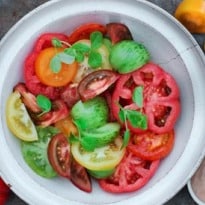Nigel Slater's green panzanella
This is a pared down version of the classic bread salad panzanella. Use the recipe as a base to add any other seasonings you wish, such as capers, olives, caperberries or crushed anchovies. As the summer progresses I tend to add more garlic, and then revert to the more traditional interpretation with tomatoes and peppers in place of the green vegetables.
SERVES 4
peas 200g, podded weight
broad beans 500g, podded weight
young fennel 150g
spring onions 4 slim
cucumber (optional) ½
bread, firm and white 120g
clove garlic ½
olive oil 6 tbsp
red wine vinegar 2 tbsp
Put a large pan of water on to boil. Salt it lightly then cook the peas in it for 3-4 minutes. Lift them out with a draining spoon. Cool the peas in a colander under cold running water then add the broad beans to the boiling water. Cook for 4-5 minutes until tender then drain and remove the skins. Cool under running water then add to the peas.
Shred the fennel finely and put in a bowl. Trim and finely chop the spring onions and add to the fennel. Peel and chop the cucumber, if you are using it, and add to the spring onions.
Toast the bread then slice or tear it into pieces and place in a large serving bowl. Sprinkle water over the surface.
Peel and very finely chop the garlic and put in a small bowl with a little salt, black pepper, the oil and vinegar. Toss the peas and beans (and cucumber if you are using it) with the dressing then tip on top of the bread.
★ Wine match (all wines chosen by David Williams)
Asda Lugana, Italy 2012 (£7.98, Asda)
With its gentle apple blossom aromas, and juicy ripe pear fruit, this just off-dry white from around Lake Garda in northern Italy has more than enough body to cope with the dressing.
Russell Norman's warm octopus salad
You might have to ask your fishmonger to order an octopus for you. You need just a small beast for this recipe, about the size of a grapefruit. I love the gentle spice in this salad; it reminds me of the use of smoked paprika in the traditional Spanish preparation of octopus.
SERVES 4
medium octopus 1, about 1½-2kg
fennel bulb 1, cut in half
onion 1, cut in half
celery stalks 2, cut roughly
parsley stalks 1 handful, roughly chopped
medium waxy potatoes 3, peeled
garlic clove 1, finely chopped
flat parsley leaves 1 handful, chopped
chilli flakes 1 tsp
extra virgin olive oil 4 tbsp
lemon juice 1 tbsp
First you need to soften up your octopus. You do this simply by freezing it and then thawing; this breaks down the toughness in the cellular structure of the flesh.
In a very large pan, simmer the octopus in unsalted water on a medium-low heat with the fennel, onion, celery and parsley stalks until tender enough to push a fork easily through the flesh. This should take no more than 1 hour. Remove the octopus from the cooking water and allow it to cool. Cut the cooked and cooled octopus into bite-sized pieces, discarding the eyes, beak and the mush inside the head. Remove the skin. Rinse the cut pieces in clean water.
Cut the peeled potatoes into bite-sized pieces, put into a pan of water, bring to the boil and then simmer until cooked - they should not disintegrate. Drain and set aside.
In a large mixing bowl, gently combine the octopus and potatoes with the garlic, parsley and chilli flakes. Season with salt and pepper and dress with olive oil and lemon juice.
Transfer the dressed octopus to a large serving plate and cover with clingfilm. When you are ready to serve, put the dish in a microwave on full for 30 seconds so that the potatoes and octopus gain a little warmth.
If you don't have a microwave, time the dish so that the drained potatoes are still warm when you mix them with the other ingredients and the dressing.
The Polpo Cookbook by Russell Norman (Bloomsbury, RRP £25). To order a copy for £17 with free UK p&p, click here
★ Wine match
Pieropan Soave Classico, Italy 2012 (from £13.29, Noel Young Wines; Roberson)
Choose a wine that you'd be likely to find on the list at a Venetian osteria: Soave. Pieropan makes some of the best.
Sam Harris's heritage tomatoes and anchovy salad
I could eat this for breakfast, lunch and dinner.
SERVES 4-6
mixed heritage tomatoes (get a good range of colours) 500g
red wine vinegar a splash
olive oil
anchovy fillets in olive oil 130g
cold water 1-2 tbsp
sugar a pinch
lemon juice 1 tsp
peashoots a handful
Cut the tomatoes into odd shapes and place in a bowl, add a splash of red wine vinegar, a glug of olive oil and a pinch of salt and leave for 20 minutes.
Blend the anchovy fillets with a tablespoon or two of cold water, a pinch of sugar, a teaspoon of lemon juice and a pinch of salt - it needs to be loose but not overtly runny, more like single cream consistency. To serve, add enough of the dressing to the tomatoes for your own taste, then tip on to a large white platter and scatter with peashoots.
★ Wine match
Prieuré de Montézargues Tavel, Rhône 2012 (from £13, L'Art du Vin; Berry Bros & Rudd; Uncorked)
A tricky match thanks to the acidity of the tomatoes, vinegar and lemon, plus the salty pungency of the anchovies. I'd go for a relatively robust rosé, with sufficient depth of red fruit flavour and a cranberryish acidity.
Pitt Cue's barbecue chicken wings
The brining in this recipe might seem a hassle, but it makes a difference. It seasons the wings to the bone, helps retain moisture, and can produce amazing crisp skin when finished on a hot grill.
SERVES 4
For the master chicken brine
water 4 litres
Maldon sea salt 180g
muscovado sugar 60g
spice bag 1 (dried chillies, peppercorns, cumin, star anise, cloves, coriander seed, liquorice stick)
herbs 1 faggot (thyme, bay, rosemary)
For the chicken wings
chicken wings whole, 3-joint, free-range 1kg
chicken dry rub 100g (50/50 granulated sugar/sea salt is a good base then add whatever spices you wish - toasted fennel seed, coriander, cumin, paprika, pepper, oregano, thyme, onion powder, cayenne)
hot sauce 50ml
barbecue sauce 100ml
unsalted butter 200g
cider vinegar 100ml
You will also need
instant read thermometer
Make the brine in advance. Bring all the ingredients to the boil in a pot. Allow to cool. Add wings and leave for up to 24 hours. If you do not have time for this, 4 hours or so will suffice. Leave the wings to dry a little on a clean towel in the fridge once removed from the brine.
Make sure you have a meat thermometer - essential for consistent barbecuing. Set smoker for indirect cooking with the burning coals pushed to one end, the barbecue and the cooking area for the wings on the other. Toss a small handful of wood chunks on the coals and close the lid. You should try to keep the temperature in the barbecue at around 105C so adjust your air vents until you find the temperature - 100-110C is fine. Too much higher and there will be the danger of drying out the meat.
Once the wings are dry, rub them thoroughly with the dry rub. Place the wings on the barbecue and close the lid. After 30-45 minutes, check to make sure the barbecue is behaving and give the wings a turn. Try to check as little as possible thereafter, so as not to lose moisture and heat. Wings need to reach at least 70C internal temperature. About 1½ hours should be plenty, but be patient and only remove when ready. Similarly, if they cook quicker, remove when they hit 70C.
Meanwhile, add the hot sauce, the barbecue sauce, butter and vinegar to a pan and gently cook down for 5 minutes until fully emulsified. A whisk might be helpful. Season with salt and transfer to a large mixing bowl.
Once the wings are cooked, remove from the barbecue and let sit. Crank up the barbecue for direct grilling - not super-hot but just enough to finish the wings on the grill until crisp, caramelised and slightly charred.
Toss the wings in the hot sauce until well covered and serve immediately with pickles and a beer. Remember to use lots of napkins.
★ Wine match
Tesco Finest Kulapelli Cabernet Carmenère, Maipo, Chile 2012 (£8.99, Tesco)
A well-made, barbie-ready red that's robust enough to cope with the intense marinade and smoky-charry flavours, but not so heavy it will knock you for six.
Omar Allibhoy's peas with serrano ham
SERVES 3
peas 250g
eggs 3
garlic cloves 4, thinly sliced
Spanish olive oil 1 good drizzle
jamón Serrano (cured ham) 4 slices, chopped
dry sherry, such as amontillado 2 tbsp
chicken stock 100ml
fresh mint leaves a few
To me, peas are better than caviar, full of flavour and sweetness. This recipe for peas with jamón Serrano and a soft-boiled egg brings out the best in peas. Don't miss out.
Bring a large pan of salted water to the boil and add the peas and eggs (wash them first) at the same time. Cook for no longer than 5 minutes. If you're using frozen peas, don't worry that the water goes cold and it takes a while to come back to the boil, both the eggs and peas will cook to perfection.
Drain in a colander and rinse the eggs under cold running water to cool down a little.
Meanwhile, place a large frying pan over a medium heat and add the sliced garlic and a drizzle of olive oil. After a minute, add the chopped jamón and fry quickly until it goes crisp (take care not to let the garlic go too brown).
Add the sherry and then quickly light it with a lighter or some long matches to flambé the pan. Add the chicken stock, fresh mint, seasoning and drained peas and cook for 1 minute before transferring to warmed plates.
Peel the warm eggs carefully and cut in half - they should be quite soft, not hard-boiled. Place on top of the peas and sprinkle with a few flakes of sea salt. At this point I can't resist drizzling over a little more olive oil.
Tapas Revolution by Omar Allibhoy (Ebury, RRP £20). To order a copy for £14.99 with free UK p&p click here.
★ Wine match
Marks & Spencer Dry Old Amontillado Sherry, Spain NV (£7.49)
This recipe calls for a glass of amontillado sherry - you can put the remains of this superb half bottle in the fridge until you've finished cooking to serve as an umami-rich foil for the sweetness of the peas.
Sam Harris's heritage tomatoes and anchovy salad. Photograph: Jean Cazals for the Observer







